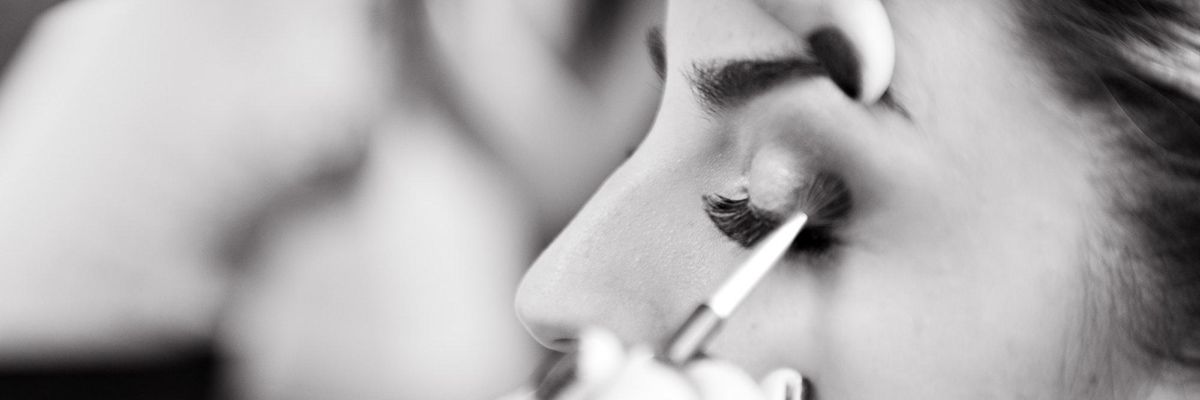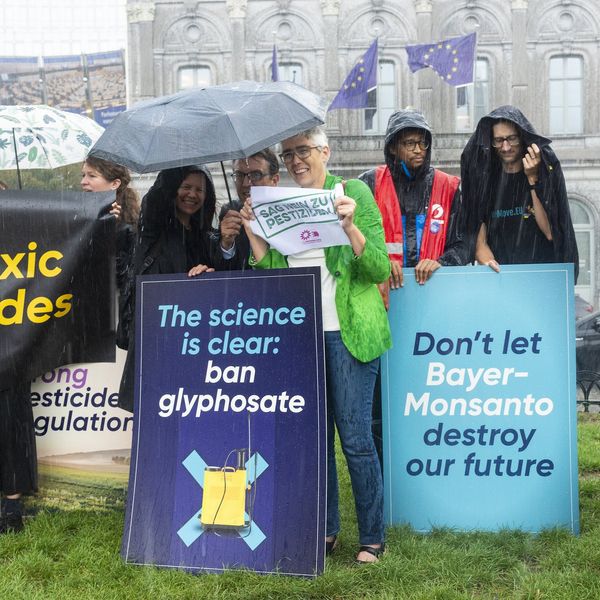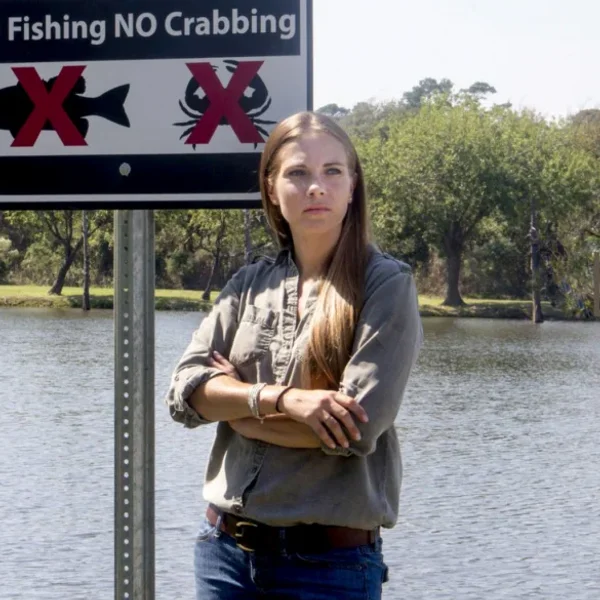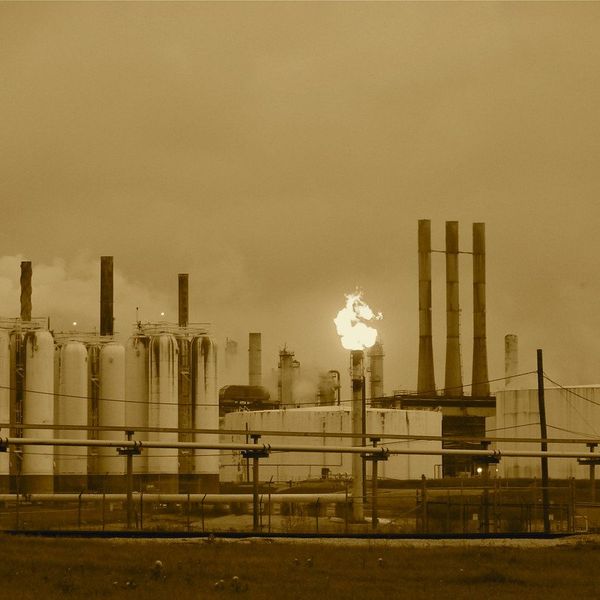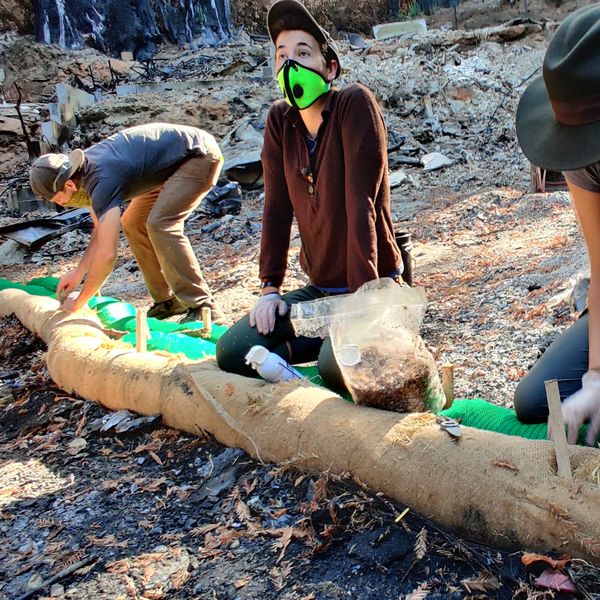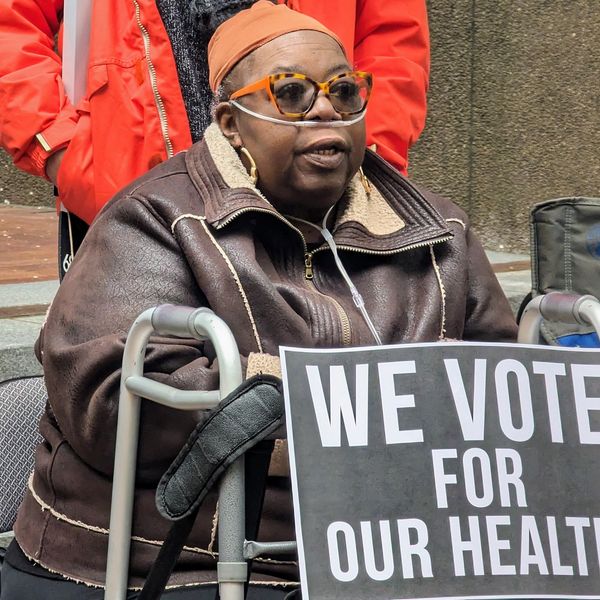After a bombshell study came out last summer showing that a number of cosmetics contained PFAS, a class of compounds linked to cancer and reproductive problems, small-scale Oregon beauty company Axiology sent a suite of its products for testing.
The results showed no indicators for PFAS.
But last fall, testing from the consumer wellness blog Mamavation found that one of Axiology’s lip balms and dozens of makeup products from other brands contained organic fluorine, an indicator for PFAS.
“We were absolutely stunned,” Lauren Evashenk, sustainability consultant for Axiology, told EHN. “The results were not slightly different [from Axiology’s testing] — they’re astronomically different.”
Related: What are PFAS?
On first blush, the Mamavation testing appeared to indicate widespread contamination — and in a few cases, the intentional addition — of the harmful compounds in beauty products marketed as clean or green, which are ill-defined terms in this space but indicate brands that market themselves as selling toxic-free products. A few brands whose makeup initially had the PFAS, which stands for per- and poly-fluoroalkyl substances, indicator worked to reformulate their products or remove the contamination from packaging and supply chains.
But clean beauty brands and some experts say that inconsistencies in testing and a lack of transparency from ingredient suppliers and manufacturers creates challenges for companies who are trying to keep PFAS out of their makeup.
“It's very easy for PFAS to get into the supply chain accidentally in many different places,” Lydia Jahl, science and policy associate at the Green Science Policy Institute, told EHN. “Even the most well-intentioned brands could experience PFAS problems.”
PFAS common in makeup

Of the 83 lipsticks, mascaras, and other beauty products that Mamavation tested, 54 had organic fluorine, with eight containing organic fluorine levels higher than 100 parts per million. (Credit: Leah Segedie/Mamavation)
PFAS, originally developed for military use, are used to water- and grease-proof everything from cooking pans to raincoats. The compounds made headlines in recent years as researchers and government officials found PFAS-contaminated drinking water around the U.S., especially near factories where PFAS are made or used in industrial processes and military bases where PFAS-containing firefighting foam is used.
Certain kinds of PFAS, which number in the thousands, have been linked to a number of serious health concerns, including increased risks of kidney and testicular cancers, liver harms, higher cholesterol levels, immune system effects, and elevated blood pressure in pregnant women. Researchers are especially concerned about PFAS exposure for fetuses and infants, who could be exposed through breast milk and infant formula.
A growing body of evidence suggests that we’re also exposed to PFAS in our food and through everyday products like rain jackets and comforters and athletic wear.
The compounds can be added to makeup to make products water-resistant, longer-lasting, and more spreadable. Until last year, there were no studies looking at how much PFAS were in North American cosmetics, although the U.S. Food and Drug Administration is notoriously hands-off in regulating the safety of personal care products. With that in mind, a team of researchers from the University of Notre Dame, Indiana University, and other institutions tested more than 200 mascaras, concealers, eye shadows, and other cosmetics from North America.
What
they found surprised the researchers: roughly half the products they tested contained the PFAS indicator organic fluorine. Colored lipsticks, mascaras, and foundations advertised as “long-lasting” or “wear-resistant” had particularly high levels.
The researchers took 29 products, including 20 with the highest fluorine levels, and analyzed them for the presence of more than 50 specific PFAS. One of the key classes of PFAS they found, lead study author and University of Notre Dame PhD candidate Heather Whitehead told EHN, was fluorotelomer alcohols, which can break down in our bodies into the compounds PFOA and PFOS — compounds that are prohibited from being produced in the European Union and U.S. because of long-known health risks.
Follow our collaboration with Mamavation on PFAS testing
Makeup is often applied near the eyes and mouth, representing direct ways for the compounds to enter our bodies. And there’s some evidence that PFAS can be absorbed through our skin, although unknowns abound. “I'm concerned about (exposure from) lipstick and lip gloss because you usually eat during the day, and you can apply it several times a day,” Amina Salamova, an environmental chemist at Emory University’s Rollins School of Public Health, told EHN.
Meanwhile, a 2018 Danish Ministry of Environment study concluded under a conservative analysis that the levels of PFAS in cosmetics were too low to pose a risk for wearers. Some environmental health experts have cautioned, though, that PFAS-containing makeup represents yet another source of daily exposure to and source of the compounds whose use, they say, should be restricted to all but “essential” uses.
The Notre Dame study also prompted Mamavation, whose readers gravitate toward more environmentally-friendly products, to test for organic fluorine in makeup from green beauty brands. Mamavation tested for organic fluorine, rather than individual PFAS, because that testing would be significantly more expensive, and tests only exist for a limited number of the compounds.
EHN.org partially funded the testing. Pete Myers, chief scientist of Environmental Health Sciences, which publishes EHN, reviewed the findings.
Of the 83 lipsticks, mascaras, and other beauty products that Mamavation tested, 54 had organic fluorine, with eight containing organic fluorine levels higher than 100 parts per million — amounts that experts say could indicate the intentional use of PFAS as an ingredient.
Leah Segedie, founder of Mamavation, talked with brands before publishing the test results and said she understood the concerns around high test costs and the amount of work it would take to ensure clean supply chains. “But the point is you're still selling this makeup to people who … are paying top dollar for cleaner cosmetics that keep them safer because they have to wear it every day,” she said. “So, all the more reason you need to figure this out.”
One of the brands, Coastal Classic Creations, whose lipstick contained more than 100 parts per million of organic fluorine, told EHN that the issue was fixed once they reformulated their product, and that they did not intentionally add PFAS to their beauty products.
Burt’s Bees, which had multiple mascaras with high levels of organic fluorine, did not respond to multiple requests for interviews. In the wake of the Mamavation testing, the company, which does not list PFAS among its banned ingredients, now faces a class-action lawsuit over allegedly misrepresenting the safety and natural origins of its products.
Other beauty brands that Mamavation tested say that they, too, are concerned about PFAS in cosmetics, and that they’re puzzled by discrepancies between results from different types of fluorine testing.
A complicated supply chain

Clean beauty brands will tell manufacturers what ingredients they don’t want in their products and can ask for a detailed ingredient list, but there’s no requirements in the U.S. that the manufacturers or ingredient suppliers further upstream disclose trace amounts of ingredients. (Credit: Jazmin Quaynor/Unsplash)
Last summer’s study on PFAS in cosmetics unleashed a torrent of news coverage, bills, and even a spate of class-action lawsuits against makeup brands like CoverGirl, bareMinerals, and L’oreal over allegations of false advertising.
For brands that try to avoid using toxic ingredients in their products, the news that PFAS seemed to be showing up as unlabeled ingredients was distressing.
Credo Beauty, a clean beauty retailer that bans 2,700 ingredients used in conventional beauty products, added PFAS to their list of banned ingredients in 2019, Mia Davis, vice president of sustainability and impact at Credo, told EHN. Some of the cosmetics that Mamavation found had organic fluorine were from brands sold at Credo.
While Credo did not at first require that brands test their products for PFAS, the retailer has partnered with clean makeup brand Beautycounter on strategies to reduce the risk of PFAS contamination, including determining what questions and documentation to ask of suppliers and what kinds of tests to use.
Related: Unintentional PFAS in products: A “jungle” of contamination
Many clean beauty brands are relatively small and don’t own manufacturing facilities, meaning they hire contract manufacturers to produce their lipsticks or foundations. This model makes sense from an economic perspective, but it poses challenges in making sure that unwanted ingredients aren’t getting into makeup.
Clean beauty brands will tell manufacturers what ingredients they don’t want in their products and can ask for a detailed ingredient list, but there’s no requirements in the U.S. that the manufacturers or ingredient suppliers further upstream disclose trace amounts of ingredients. This can be especially problematic in the case of PFAS, which can be used to coat other ingredients like pigments or mica, a mineral used in makeup to add a shimmer. PFAS are also used in nonstick coating for manufacturing equipment, in cleaning products, and in coatings for plastics used to transport raw ingredients or package products — representing other ways for the compounds to end up in makeup.
“Oftentimes, those suppliers don't know the answers to the questions you're asking even though they should be the expert, or they don't want to look for the answers because they don't want to tell you what it is,” Lindsay Dahl, senior vice president at the clean cosmetics brand Beautycounter*, told EHN. “Or they just flat out send you a piece of paper that says whatever you want it to say.”
PFAS testing challenges

Brands can face long wait times in getting PFAS testing done because there are few labs doing this testing, although that’s likely to change as demand increases. (Credit: Scott Ableman/flickr)
For beauty brands to verify manufacturer and supplier claims that they’re not using any PFAS-containing ingredients, they need to test their makeup, according to the Green Science Policy Institute. For cosmetics, though, that’s not as easy it sounds.
The Green Science Policy Institute, whose scientists were among the authors on the makeup study out last summer, recommends that brands test their makeup for organic fluorine in addition to targeted PFAS testing. Testing a batch of makeup for organic fluorine is $100-300 a pop, while targeted PFAS testing is around $10 a compound, Jahl said.
There are an estimated 8,000-9,000 individual PFAS compounds out there, but many of their exact formulas are industry secrets, Whitehead, the lead author on the makeup study, said. “The 53 compounds that we look for are compounds that you can go to an external company, order a high-quality standard, and then be able to use that as a reference so that when you look at samples to know definitively that that's what you're measuring,” she said. Organic fluorine testing can help provide information about all PFAS — not just those for which tests exist.
But organic fluorine testing in cosmetics poses its own challenges. Cosmetics as a class of products are much more varied than, say, drinking water, said Jahl, and individual products don’t necessarily have a uniform texture. PFAS tend to pool in cosmetics, meaning a sample taken from one part of a product could have much different fluorine levels than in another area.
Davis said that while the organic fluorine testing they had done on Credo products from one lab, which uses a method called “extractable organic fluorine” that first takes out inorganic fluorine, came back negative, results from the lab used by Mamavation, which uses a different method that wasn’t designed for use on cosmetics, were more varied. In some cases, the same makeup product had fluorine results differing by up to 100 parts per million.
Segedie, from Mamavation, had four makeup products re-tested three times each this year, finding that results from that round of testing and the original testing were only off by a couple of parts per million.
Experts say that the extractable organic fluorine test could be less sensitive to PFAS polymers, like Teflon, which is used both as an ingredient in conventional makeup products and as a coating for equipment and plastics. Meanwhile, the other kind of testing used by Mamavation could be better at picking up those polymers, “but there could be things that we don't know about that are causing their results to be artificially too high,” said Jahl. “It’s difficult to say.”
“We still encourage brands to do testing and figure out what's in their products,” she said.
Brands also can face long wait times in getting testing done because there are few labs doing this testing, although that’s likely to change as demand increases.
Researchers and brands alike agree that there’s a need for more standardized tests for cosmetics that can capture the full array of PFAS that can sneak into makeup.
Yashi Shrestha, director of science and research at Novi Connect, which works with beauty brands and other companies on product development and environmental claim verification, told EHN that the industry also needs to come to a consensus on what constitutes an “unavoidable” level of background PFAS contamination, given how ubiquitous the compounds are in water supplies.
“We prohibited perfluorinated compounds for good reason, we're not debating" that, said Davis. “It's just that you can't actually say it needs to be non-detect all the time, no exceptions.”
Legislation to get PFAS out of makeup
Researchers and advocates say the U.S. should ban PFAS as cosmetic ingredients — and in other consumer products. There’s a federal bill in the works — the aptly named “No PFAS in Cosmetics Act,” introduced by Sen. Susan Collins, R-ME in the Senate and Rep. Debbie Dingell, D-MI, in the House — that would do just that. The nonprofit Breast Cancer Prevention Partners is advocating for “The Toxic-Free Beauty Act,” introduced by Rep. Jan Schakowsky, D-IL, and Rep. Lizzie Fletcher, D-TX, in the House, which would ban PFAS, formaldehyde, two kinds of phthalates, and other ingredients linked to health harms from personal care and salon products.
Supporters also argue that these types of bans could help make safer cosmetics more affordable for all, given that clean beauty products tend to be pricier.
“Ultimately, we’d love if there was a complete ban on PFAS in cosmetics, because it's really not a necessary use of PFAS,” said Whitehead. Acknowledging challenges in getting any federal legislation passed, Whitehead said that she and other researchers at least want to see labeling requirements updated for personal care products so that PFAS have to be listed as an ingredient to provide a “bare minimum of protection for the consumer.”
Consumers can use the web browser extension Clearya to automatically screen makeup products they’re looking at for PFAS and other hazardous ingredients. The Environmental Working Group’s Skin Deep Database provides safety reviews of thousands of cosmetics, sunscreens, and other personal care products.
While progress might be slow at the federal level, states are forging ahead. Maine banned the sale of PFAS in all products, including cosmetics, except when their use was "currently unavoidable," starting in 2030. California and Maryland banned the sale of any cosmetics with some PFAS starting in 2025. "I actually do think there's going to be regulations around PFAS that brands are watching out for and trying to get ahead of," said Shrestha.
Clean makeup companies and environmental health advocates are also pushing for a bill called the Cosmetics Supply Chain Transparency Act, introduced by Rep. Jan Schakowsky, D-IL in the House, which would require ingredient suppliers to provide beauty brands with full ingredients and their safety data. Currently, there’s no federal law requiring that these upstream suppliers disclose that information, according to the Breast Cancer Prevention Partners.
Changes in customer expectations and brand promises could also help get PFAS and other toxic chemicals out of cosmetics in the beauty industry writ large. “Maybe we don't talk about having 24-hour lipstick as a claim,” said Shrethsa, “It's okay to reapply and not have toxic chemicals in our products.”
Follow our PFAS testing project with Mamavation at the series landing page.
Want to know more about PFAS? Check out our comprehensive guide.
Have something you want tested for PFAS? Let us know and write us at feedback@ehn.org.
*Beautycounter partially supports the Agents of Change in Environmental Justice Podcast produced by EHN.org.
Banner photo: Jamie Coupaud/Unsplash
- Investigation: PFAS on our shelves and in our bodies - EHN ›
- Unintentional PFAS in products: A “jungle” of contamination - EHN ›
- What are PFAS? - EHN ›
- States will weigh more than 210 bills on toxic “forever chemicals” in ... ›
- CoverGirl Sued For PFAS contamination - EHN ›
- Green beauty product testing finds more than 60% have PFAS ... ›
- New Washington state bill is the “fastest timeline in the nation” for phasing out PFAS - EHN ›
- Evidence of PFAS in organic pasta sauces - EHN ›
- Workers exposed to PFAS in a variety of industries - EHN ›
- WATCH: PFAS "forever chemicals" on our shelves and in our bodies - EHN ›
- Evidence of PFAS in toilet paper. (Yes, toilet paper!) - EHN ›
- Evidence of PFAS in toilet paper. (Yes, toilet paper!) - EHN ›
- LISTEN: Beauty + Justice - EHN ›
- Racist beauty standards leave communities of color more exposed to harmful chemicals - EHN ›
- EHN partner featured in Consumer Reports' citizen science feature - EHN ›
- LISTEN: Marissa Chan on solutions to harmful beauty products - EHN ›
- Evironmental Health News and Mamavation PFAS investigation featured in TIME - EHN ›
- It’s not just hair — fighting beauty injustice beyond the individual - EHN ›
- LISTEN: Denise Moreno Ramírez on protecting workers in auto shops and beauty salons from toxics - EHN ›



